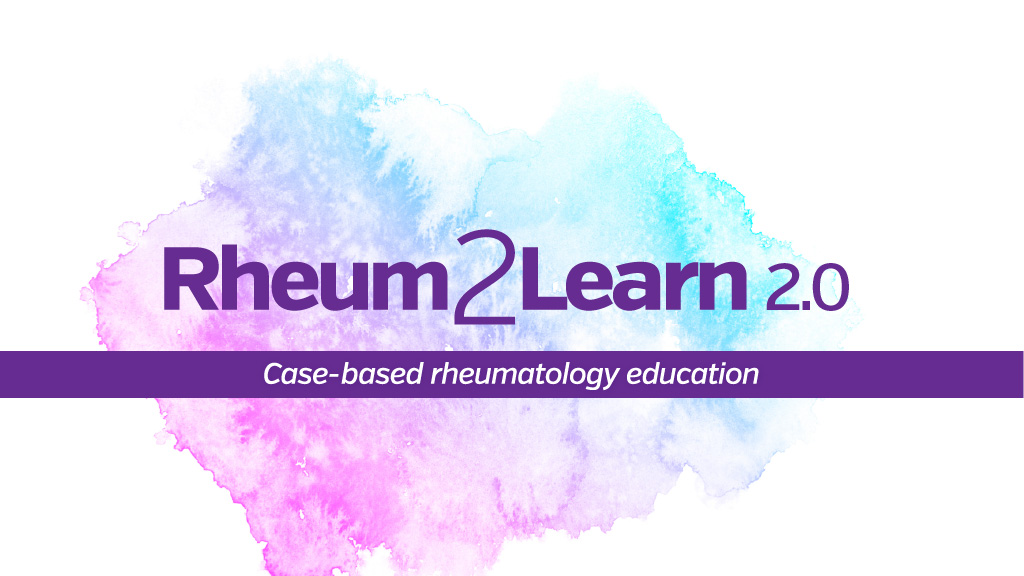
Rheum2Learn 2.0: Inflammatory Myopathies
Activity Overview
Rheum2Learn 2.0 is case-based fundamental clinical rheumatology education for residents. Each interactive activity includes three patient cases that focus on the care and assessment of individuals with rheumatologic diseases.
In this activity, learn how to identify clinical manifestations, interpret test results, and develop a differential diagnosis and treatment plan for patients with inflammatory myopathies. Topics include myositis, abnormal hyperCKemia (CK), dermatomyositis, and anti-synthetase syndrome.
Rheum2Learn 2.0 Series
This activity is part of a series. See all activities in the series below.
- Rheum2Learn 2.0: Crystalline Arthritis
- Rheum2Learn 2.0: Infectious Arthritis
- Rheum2Learn 2.0: Inflammatory Myopathies
- Rheum2Learn 2.0: Musculoskeletal Disorders
- Rheum2Learn 2.0: Musculoskeletal Examination
- Rheum2Learn 2.0: Osteoporosis
- Rheum2Learn 2.0: Osteoarthritis
- Rheum2Learn 2.0: Pediatric Rheumatology
- Rheum2Learn 2.0: Rheumatic Manifestations of Systemic Disease
- Rheum2Learn 2.0: Rheumatoid Arthritis
- Rheum2Learn 2.0: Sjögren’s Disease
- Rheum2Learn 2.0: Spondyloarthritis
- Rheum2Learn 2.0: Systemic Lupus Erythematosus
- Rheum2Learn 2.0: Systemic Sclerosis
- Rheum2Learn 2.0: Systemic Vasculitis
Registration is complimentary.
Target Audience
Residents in training who may provide care for patients with rheumatic diagnoses in primary care, inpatient, critical care, and other clinical contexts.
The activity may also be of interest to medical students, fellows in training, advanced practice providers, practicing physicians, and other health care professionals who seek to strengthen their clinical knowledge of rheumatic diseases.
Learning Objectives
Upon completion of this activity, participants should be able to:
- Differentiate among non-neuromuscular and neuromuscular causes of elevated hyperCKemia (CK) levels
- Describe clinical history and physical exam to evaluate hyperCKemia
- Propose appropriate laboratory studies to evaluate hyperCKemia
- Recognize when appropriate to refer to neurology and/or rheumatology for evaluation
- Describe physical exam maneuvers of the neuromuscular exam to assess weakness
- Identify common skin findings associated with dermatomyositis
- Explain the role of laboratory, imaging, and pathology in diagnosing dermatomyositis
- Recognize association of dermatomyositis with malignancy (ovarian cancer) - paraneoplastic, malignancy screening
- Formulate a differential for a patient with shortness of breath, cough, and fatigue
- Describe clinical features of anti-synthetase syndrome
- Explain the role of laboratory tests and imaging in diagnosing anti-synthetase syndrome
- Recognize appropriateness of referral and hospital admission
CE & MOC Information
This activity is not eligible for CME/MOC.
Acknowledgement of Commercial Support
The project was supported by grant number 1 NU58DP006908-01-00 – Component A: Developing and Disseminating Programs to Build Sustainable Lupus Awareness, Knowledge, Skills and Partnerships. Its contents are solely the responsibility of the authors and do not necessarily represent the official views of the Department of Health and Human Services, Centers for Disease Control and Prevention.
Educational Activity Policies
See ACR educational activity policies, including the online enduring activity refund policy.